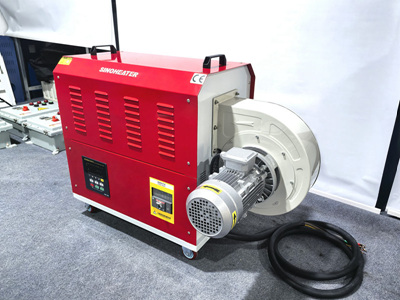Thermal Dynamics of Hot Air Heating in Plastic Welding Processes
Convection-Based Heating Mechanism
Hot air welders utilize forced convection to transfer thermal energy to plastic surfaces. Compressed air or inert gases are heated to temperatures ranging from 200°C to 400°C using electric heating elements, then directed through precision nozzles onto target areas. This method ensures uniform temperature distribution across irregular geometries, critical for welding polyethylene (PE), polypropylene (PP), and polyvinyl chloride (PVC) components.
The heating efficiency depends on airflow velocity and nozzle design. Circular nozzles create isotropic heat patterns suitable for flat surfaces, while triangular nozzles enable targeted heating of V-shaped or HV-shaped welds. In industrial applications, such as chemical storage tank fabrication, convection heating achieves consistent melt penetration without localized overheating, preventing material degradation.
For oxygen-sensitive polymers like polyamide (PA), nitrogen or carbon dioxide replaces air to prevent oxidative decomposition. This adaptation extends the applicability of hot air welding to aerospace and automotive components requiring stringent material integrity.
Material-Specific Temperature Regulation
Thermal control systems adjust output based on polymer characteristics. Amorphous plastics such as polystyrene (PS) and polycarbonate (PC) require precise temperature management to avoid crystalline formation, which would compromise transparency and impact resistance. Semi-crystalline materials like high-density polyethylene (HDPE) demand higher melting temperatures to activate molecular chain diffusion across interfaces.
In pipeline construction, infrared thermometers monitor surface temperatures during field welding. Real-time adjustments prevent incomplete fusion in butt welds, a common failure mode in underground water distribution systems. Similarly, medical device manufacturers use PID controllers to maintain ±2°C accuracy when joining polyvinylidene fluoride (PVDF) tubing, ensuring compliance with biocompatibility standards.
Dynamic Pressure Application During Melting
Simultaneous pressure application enhances molecular interdiffusion. Roller systems exert 0.5–5 MPa of force on melted plastic interfaces, compressing voids and promoting entanglement of polymer chains. This dual-action mechanism achieves tensile strengths exceeding 80% of base material properties in PP filter bag assemblies.
For large-scale structures like industrial silos, automated welding heads integrate pressure feedback loops. Sensors detect resistance variations during roller movement, adjusting force parameters to maintain optimal melt viscosity. This capability reduces rework rates from 12% to below 3% in continuous welding operations.
Cooling Phase Optimization
Controlled cooling solidifies welds without residual stress. Natural convection suffices for thin-walled components, while forced air cooling accelerates cycle times in automotive bumper manufacturing. Quenching with room-temperature air minimizes crystallization in semi-crystalline polymers, preserving ductility in high-stress applications.
In marine environments, saltwater exposure necessitates gradual cooling to prevent microcracking. Submerged cooling systems used in offshore pipeline installations demonstrate 25% longer fatigue life compared to air-cooled counterparts. Advanced simulations model thermal gradients during solidification, guiding nozzle positioning and cooling duration in complex geometries.
Environmental Adaptation Strategies
Ambient conditions significantly impact welding quality. Humidity levels above 60% require pre-drying of hygroscopic materials like acrylonitrile butadiene styrene (ABS) to avoid bubble formation. Windy environments necessitate shielding systems to maintain consistent airflow patterns, critical for outdoor infrastructure projects.
In arctic regions, preheating substrates to 10–15°C above ambient prevents thermal shock during welding. Conversely, desert operations implement cooling jackets around heating elements to prevent overheating. These adaptations ensure process reliability across global manufacturing sites, from Canadian oil sands to Middle Eastern desalination plants.




